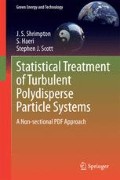Abstract
Multi-phase flows are encountered in many engineering and environmental systems. For example, controlling combustion to enable efficient fuel consumption is only possible by understanding the atomization, dispersion, and evaporation processes of fuel droplets in the combustion system.
Access this chapter
Tax calculation will be finalised at checkout
Purchases are for personal use only
References
Gorokhovski M, Herrmann M (2008) Modeling primary atomization. Annu Rev Fluid Mech 40:343–366
Crowe C (2000) On models for turbulence modulation in fluid/particle flows. Int J Multiphase Flow 26:719–727
Scott SJ, Karnik AU, Shrimpton JS (2009) On the quantification of preferential accumulation. Int J Heat Fluid Flow 30:789–795
Shaw R (2003) Particle-turbulence interactions in atmospheric clouds. Annu Rev Fluid Mech 35:183–227
Shrimpton J (2003) Pulsed charged sprays: application ro disi engines during early injection. Int J Numer Meth Eng 58:513–536
Feath G (1983) Evaporation and combustion in sprays. IEEE Trans 1A–19:754–758
Grace J (1986) Contacting modes and behaviour classification of gas-solid and other two-phase suspensions. Can J of Chem Eng 64:1953–1966
Gidaspow (1994) Multiphase flow and fluidization. Academic Press, New York
Geldart D (1973) Types of gas fluidization. Powder Technol 7:185–195
Clift R, Grace J, Weber M (1978) Bubbles, drops and particles. Academic Press, New York
Bi HT, Grace JR (1995) Flow regime diagrams for gas-solid fluidization and upward transport. Int J Multiphase Flow 21:1229–1236
Bi HT, Grace JR, Lim KS (1995) Transition from bubbling to turbulent fluidization. Ind Eng Chem Res 34:4003–4008
Mandhane M, Gregory GA, Aziz K (1974) A flow pattern map for gas-liquid flow in horizontal pipes. Int J Multiphase Flow 1:537–553
Beggs D, Brill J (1973) A study of two-phase flow in inclined pipes. J Petrol Technol 25: 607–617
Xu J, Cheng P, Zhao T (1999) Gas liquid two-phase flow regimes in rectangular channels with mini/micro gaps. Int J Multiphase Flow 25:411–432
Furukawa T, Fukano T (2001) Effect of lquid viscosity on flow patterns in vertical upward gas-liquid two-phase flow. Int J Multiphase Flow 27:1109–1126
Taitel Y, Bornea D, Dukler AE (1980) Modelling flow pattern transitions for steady upward gas-liquid flow in vertical tubes. AIChE J 26:345–354
Barnea D, Shoham O, Taitel Y, Dukler AE (1980) Flow pattern transition for gas-liquid flow in horizontal and inclined pipes. Int J Multiphase Flow 6:217–225
Liu Y, Yang W, Wang J (2008) Experimental study for the stratified to slug flow regime transition mechanism of gas-oil two-phase flow in horizontal pipe. Frontiers Energy Power Eng China 2:152–157
Pantzali M, Mouza A, Paras S (2008) Counter-current gas-liquid flow and incipient flooding in inclined small diameter tubes. Chem Eng Sci 63:3966–3978
Dyment A, Boudlal A (2004) A theoretical model for gas-liquid slug flow in down inclined ducts. Int J Multiphase Flow 30:521–550
Zapke A, Krger DG (2000) Countercurrent gas-liquid flow in inclined and vertical ducts-i: flow patterns, pressure drop characteristics and flooding. Int J Multiphase Flow 26:1439–1455
Grolman E, Fortuin JMH (1997) Gas-liquid flow in slightly inclined pipes. Chem Eng Sci 52:4461–4471
Riley JJ, Patterson GS (1974) Diffusion experiements with numerically integrated isotropic turbulence. Phys Fluids 17:292–297
Rogallo R (1981) Numerical experiments in homogeneous turbulence. Technical Report 81315, NASA
Squires K, Eaton J (1990) Preferential concentration of particles by turbulence. Phys Fluids 3:1169–1178
Squires K, Eaton J (1991) Measurements of particle dispersion obtained from direct numerical simulations of isotropic turbulence. J Fluid Mech 226:1–31
Squires K, Eaton J (1991) Lagrangian and eulerian statistics obtained from direct numerical simulations of homogeneous turbulence. Phys Fluids 3:130–143
Eaton J (2009) Two-way coupled turbulence simulations of gas-particle flows using point-particle tracking. Int J Multiphase Flow 35:792–800
Elghobashi S, Truesdell G (1992) Direct simulation of particle dispersion in decaying isotropic turbulence. J Fluid Mech 242:655–700
Elghobashi S, Truesdell G (1993) On the two-way interaction between homogeneous turbulence and dispersed solid particles part 1: turbulence modification. Phys Fluids A5:1790–1801
Boivin M, Simonin O, Squires KD (1998) Direct numerical simulation of turbulence modulation by particles in isotropic turbulence. J Fluid Mech 375:235–263
Lavieville J, Deutsch E, Simonin O (1995) Large eddy simulation of interactions between colliding particles and a homogeneous isotropic turbulence field. gas-particle flows. ASME 228:359–369
Wang Q, Squires K, Chen H, McLaughlin J (1997) On the role of the lift force in turbulence simulations of particle deposition. Int J Multiphase Flow 23:749–763
Haeri S, Shrimpton J (2012) On the application of immersed boundary, fictitious domain and body-conformal mesh methods to many particle multiphase flows. Int J Multiphase Flow 40:38–55
Haeri S, Shrimpton J (2013) A correlation for the calculation of the local nusselt number around circular cylinders in the range 10 \(\le \) re \(\le \) 250 and 0.1 \(\le \) pr \(\le \) 40. Int J Heat Mass Transfer 59:219–229
Haeri S, Shrimpton J (2013) A new implicit fictitious domain method for the simulation of flow in complex geometries with heat transfer. J Comput Phys 237:21–45
Author information
Authors and Affiliations
Corresponding author
Rights and permissions
Copyright information
© 2014 Springer-Verlag London
About this chapter
Cite this chapter
Shrimpton, J.S., Haeri, S., Scott, S.J. (2014). Introduction. In: Statistical Treatment of Turbulent Polydisperse Particle Systems. Green Energy and Technology. Springer, London. https://doi.org/10.1007/978-1-4471-6344-2_1
Download citation
DOI: https://doi.org/10.1007/978-1-4471-6344-2_1
Published:
Publisher Name: Springer, London
Print ISBN: 978-1-4471-6343-5
Online ISBN: 978-1-4471-6344-2
eBook Packages: EnergyEnergy (R0)

